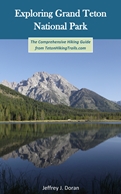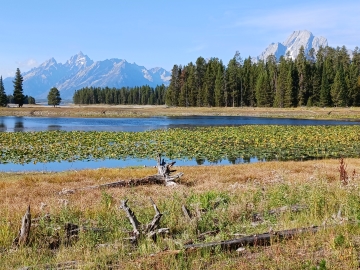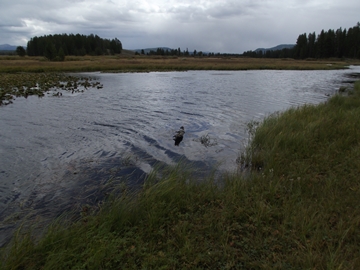

Hermitage Point
| Trail Features: | Outstanding Lake Views, Wildlife |  |
|||
| Trail Location: | Colter Bay (Hermitage Point Trailhead) | ||||
| Roundtrip Length: | 10.0 Miles | ||||
| Trailhead Elevation: | 6796 Feet | ||||
| Total Elevation Gain: | 380 Feet | ||||
| Avg. Elev Gain / Mile: | 76 Feet | ||||
| Highest Elevation: | 6903 Feet | ||||
| Trail Difficulty Rating: | 10.76 (strenuous) | ||||
| Parking Lot Latitude | 43.90115 | ||||
| Parking Lot Longitude | -110.64209 | ||||
Trail Description:
The hike to Hermitage Point begins from the Hermitage Point Trailhead, located at the south end of the Colter Bay Visitor Center parking area in Grand Teton National Park. To reach the trailhead from Jackson Lake Junction drive 5.4 miles north and turn left onto Colter Bay Village Road. From the highway drive another nine-tenths of a mile towards the parking area near the visitor center. Once at the end of the road, turn left, away from visitor center, and proceed to the far end of the south parking area.
From the parking area hikers should follow the paved road that leads down towards the boat landing area where you'll see a sign that reads "Foot Trail Only - No Road." This marks the actual trailhead for the path leading towards Heron Pond and Swan Lake.
 The hike begins by following an old service road that circles around the southern edge of the Colter Bay Marina. Almost immediately you'll enjoy some outstanding views of 12,605-foot Mt. Moran and 11,144-foot Rockchuck Peak towards the west.
The hike begins by following an old service road that circles around the southern edge of the Colter Bay Marina. Almost immediately you'll enjoy some outstanding views of 12,605-foot Mt. Moran and 11,144-foot Rockchuck Peak towards the west.
At four-tenths of a mile from the trailhead hikers will reach the Swan Lake/Heron Pond split. To continue directly towards Hermitage Point hikers should veer to the right and begin heading towards Heron Pond at this junction.
From the junction the trail becomes a dirt footpath, and soon begins following along one of the coves in Colter Bay. Shortly thereafter you'll reach another junction. Though unmarked, you'll want to proceed towards the right to continue towards Heron Pond. The network of trails in this area of the park is a little more complicated than most. If you're unfamiliar with the area it's probably a good idea to carry a detailed trail map.
Colter Bay is named for John Colter, a key member of the Lewis and Clark expedition. Although evidence is inconclusive, Colter may have been the first Euro-American to visit the Grand Tetons. During the winter of 1807-08 Colter explored the greater Yellowstone area. His route, however, is uncertain. One theory holds that he traveled via Togwotee Pass. The other commonly held view traces Colter's route through Jackson Hole, over Teton Pass, and then north along the west side of the Teton Range. No clear evidence exists to substantiate either route, only vague accounts and maps derived from interviews with Colter after his return. However, in 1933, an interesting stone was discovered near Tetonia, Idaho that may offer proof of the second theory. The stone has the name "John Colter" carved into it, and if authentic, would prove that Colter traveled the Teton Pass route. Unfortunately the Colter Stone has never been fully authenticated.
At seven-tenths of a mile hikers will reach a side trail that leads up to Jackson Lake Overlook, a perch that offers decent views of the Grand Tetons. This side trail reconnects with the main trail in roughly six-tenths of a mile. To continue directly towards Heron Pond hikers should veer left here.
At just over 1.1 miles you'll pass the southern Jackson Lake Overlook trail junction. Just beyond this junction is Heron Pond. After walking a very short distance hikers will reach a short spur trail that leads towards the water's edge. This lily-covered pond provides excellent habitat for a variety of wildlife, including great blue herons, various waterfowl and moose. You may even spot a beaver lodge near the shoreline.
 At almost 1.6 miles, as you approach the southern end of Heron Pond, hikers will reach a junction that forms a narrow X. A hard left will take you directly to Swan Lake. To continue towards Hermitage Point you should follow the trail that leads to the right.
At almost 1.6 miles, as you approach the southern end of Heron Pond, hikers will reach a junction that forms a narrow X. A hard left will take you directly to Swan Lake. To continue towards Hermitage Point you should follow the trail that leads to the right.
From the junction the trail circles around the southern end of Heron Pond. At roughly 1.9 miles you'll reach a point that overlooks Half Moon Bay, which also offers great views of Mt. Moran and the northern Tetons.
At roughly 2.4 miles hikers will arrive at the Colter Bay/Hermitage Point split. To continue towards your destination you should turn right here.
From the Heron Pond area the trail mostly travels through a fairly thick conifer forest. However, as you proceed further out onto the peninsula the terrain begins to open and views of Jackson Lake and the northern Tetons become more prominent. Depending on the wind, you may be able to hear waves crashing into the surf below as you proceed along this stretch of trail.
Over the course of the last half-mile or so to Hermitage Point the trail travels through an open sagebrush meadow that offers outstanding views of almost the entire Teton Range.
At just over 4.6 miles hikers will finally reach the end of the peninsula. This tip of land, known as Hermitage Point, provides access to a rocky beach area that offers absolutely stunning views of the Grand Tetons, arguably some of the best in the park.

Jackson Lake is the largest lake in Grand Teton National Park. This natural, glacially-carved lake was enlarged by the construction of the Jackson Lake Dam. The original dam was built in 1906, rebuilt in 1911, enlarged in 1916, and was rebuilt again by 1989 to withstand a 7.5 magnitude earthquake. The top 33 feet of the lake is utilized by farmers in Idaho for irrigation purposes. In its natural state Jackson Lake originally covered about 17,100 acres, but is now more than 25,500 acres in size. The lake is named for David E. Jackson, a trapper who purportedly spent the winter of 1829 along its shores.
After visiting Hermitage Point hikers should return to the main trail and begin walking along the southeastern side of the peninsula. Soon the trail returns to the forest. At roughly 5.25 miles the trail emerges onto another sagebrush meadow, and soon passes the side trail that leads to the Hermitage Point Backcountry Campsite on the lakeshore.
 At just over 6.4 miles the trail reaches the top of a short climb where you'll enjoy an outstanding view of the southeastern corner of Jackson Lake. This perch also overlooks an estuary that's formed by Pilgrim Creek, Second Creek and Third Creek. You'll also be able to see the Jackson Lake Dam in the far-off distance.
At just over 6.4 miles the trail reaches the top of a short climb where you'll enjoy an outstanding view of the southeastern corner of Jackson Lake. This perch also overlooks an estuary that's formed by Pilgrim Creek, Second Creek and Third Creek. You'll also be able to see the Jackson Lake Dam in the far-off distance.
Roughly 7 miles from the trailhead you'll arrive at a junction. Although you can continue in either direction, hikers should veer towards the right (which actually proceeds almost straight ahead) to avoid any backtracking on this loop.
A short distance beyond the junction hikers will pass a couple of oxbow bends in Third Creek. A little further up the trail you'll pass a swampy area overgrown with willows. This stretch offers excellent opportunities for spotting moose, as well as a variety of waterfowl.
At 7.8 miles you'll reach another split in the trail. Hikers should turn left here to begin heading towards Swan Lake. Although most of this hike travels over fairly flat terrain, the steepest climb of the day occurs just after passing this junction.
At roughly 8.4 miles hikers will arrive at the Heron Pond/Swan Lake split once again. This is the same junction that forms a narrow X. To continue towards Swan Lake hikers should turn right here.
 Just beyond this junction hikers will arrive at Swan Lake, which is also covered in pond lilies and grass, and gives it the appearance of being a large wetlands area, rather than a true lake. As you might expect from its name, this is a great place to possibly spot a trumpeter swan, among a variety of other waterfowl species.
Just beyond this junction hikers will arrive at Swan Lake, which is also covered in pond lilies and grass, and gives it the appearance of being a large wetlands area, rather than a true lake. As you might expect from its name, this is a great place to possibly spot a trumpeter swan, among a variety of other waterfowl species.
Trumpeter swans are the largest native waterfowl species in North America. They have wingspans that reach up to eight feet in width, and they stand roughly four feet high, but can reach up to nearly six feet in height if their necks and legs are fully outstretched. Hunted for their plumage in the nineteenth and early twentieth centuries, trumpeter swans nearly became extinct; however, concerted conservation efforts have resulted in a rebound in some areas.
The trail continues along the edge of the lake for a very short distance, but turns to swing back into the forest. The footpath, however, eventually migrates back to the shoreline as it approaches the northwestern end of the lake.
At 9.6 miles hikers will reach yet another junction. Although you can proceed in either direction to return back to trailhead, this hike description follows the horse trail leading towards the right. This section of trail climbs over a small hill before returning back to the trailhead. Since there's really nothing of particular note to see along this segment, we recommend taking the left fork to return along the south side of the Colter Bay Marina.


